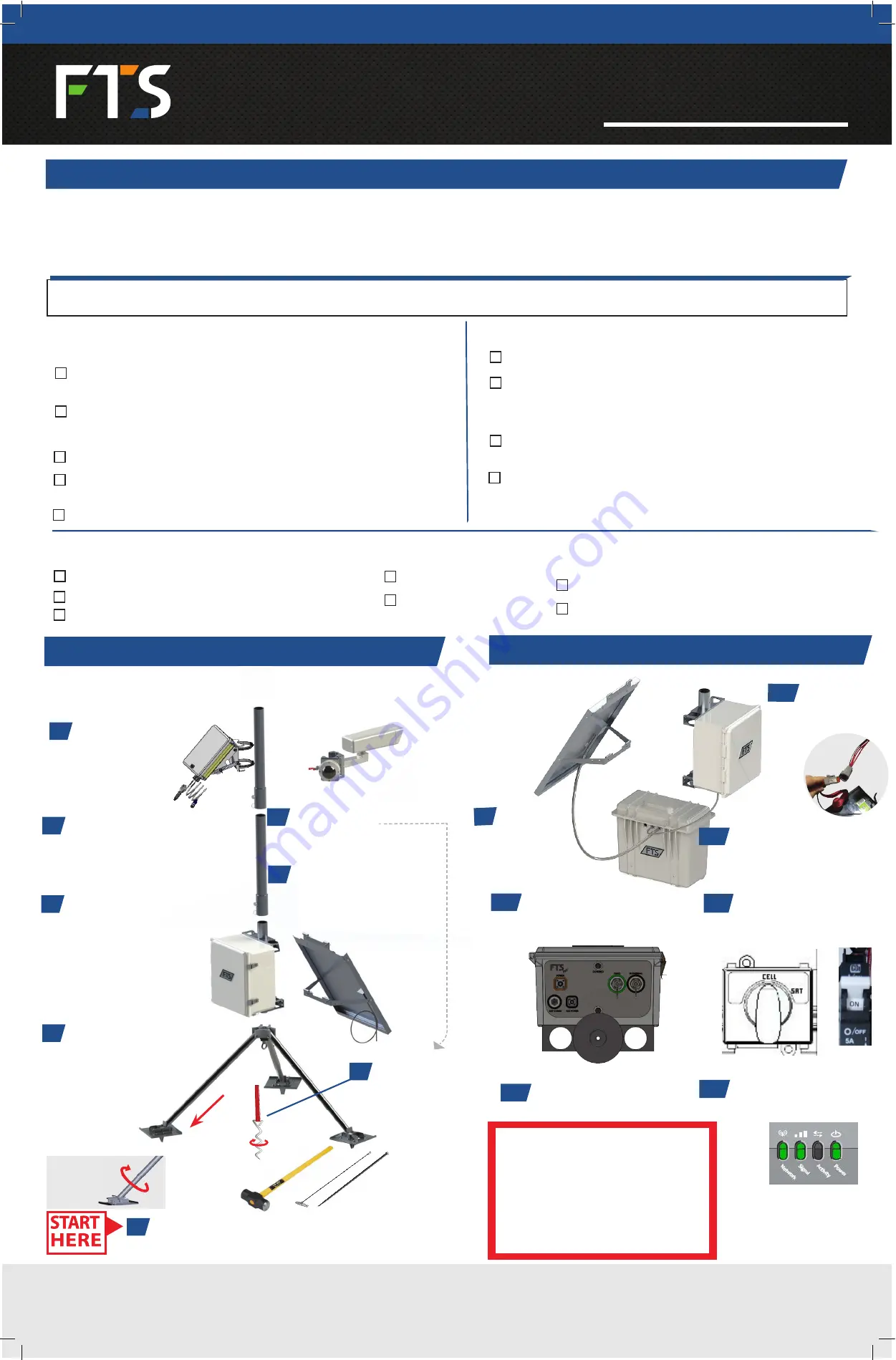
STEP 1:
FOR FTS360/FTS360 CONFIG APP
The administrator must:
Initialize FTS360 (https://360.ftsinc.com/signup or join FTS360 if
FTS initialized the account on your behalf)
Create a Technician account for the field technician
The field technician must:
Join FTS360
Download the FTS360 Config App onto the smart device that
will be used in the field (available in the Apple App Store
)
Sync the FTS360 Config App with FTS360
This guide is meant as a quick reference to install and configure a RAOS station. Refer to the following manuals (found on the FTS
Support website http://support.ftsinc.com/) for detailed instructions:
• Remote Automated Operating System Operator’s Manual (700-RAOS-Man)
• FTS360 and FTS360 Config App User Manual (700-FTS360-Man)
PORTABLE RAOS
QUICK SETUP GUIDE
OVERVIEW
A - STATION ASSEMBLY
B - CABLE CONNECTIONS
1
9
10
12
13
14
11
2
3
5
4
7
6
Screw in spiral ground anchor or drive in duck-bill anchor with
pounding rod and sledgehammer.
Attach power station
output to cabinet
input power port .
Attach
the camera cables and
satellite assembly cables to the
ports
on the bottom of the cabinet.
In the electronics cabinet, select
the desired telemetry:
For Cell:
Confirm modem operation.
(Network LED is green
for
an
LTE network;
amber if a 2G or 3G network.)
Open the power
station and connect
the battery cable.
EXTEND
Place one pole into the receiving
collar and lock in place with a
locking pin.
Repeat with second
pole and
mast cap.
Keep
a firm grip on cabinet
until secured. Place it on the
base with its back
positioned for maximum
sun exposure. Snug the
locking bolt, fine tune
cabinet position, and
tighten the locking bolt.
Fully extend tripod legs and
centre over ground anchor.
Mount lily pad feet, if using.
Adjust leg length until tripod
is level. Push spiked feet
firmly into ground.
Remove poles from storage
slots. Slide solar panel onto tab.
Swing support arm into place
and slide into the tab on the
back of the cabinet.
Clamp the camera(s) at the
desired height(s).
For satellite models, m
ount
the
satellite assembly above
the
cameras
ensuring the
terminal face is
EXTREME ENVIRONMENTS
EXTREMELY RELIABLE
8
Attach the tie down strap
to the anchor. Tighten to
remove slack but do not
take under strain.
Sledgehammer,
duckbill anchor,
pounding rod.
CANADA 1065 Henry Eng Place | Victoria, BC | V9B 6B2
USA 1124 Fir Avenue, Suite C | Blaine, WA | 98230
FTS Service and support: support.ftsinc.com | Toll free: 1-800-548-4264
Rotate leg 180°
if spike will not
penetrate ground.
700-RAOS-QS Rev
4
.0
9
Aug
2018 | Part # 19690
IMPORTANT!
Prior to proceeding to the field the following
three steps
MUST
be completed
STEP 2:
F
OR CELLULAR TELEMETRY:
STEP 3:
BRING TO THE FIELD:
The smart device with synced FTS360 Config App
#7 flathead screwdriver
5/16" socket driver
WARNING!
•
IF IN SATELLITE MODE,
ONCE POWER IS
SUPPLIED
AND TERMINAL IS TRANSMITTING
,
MAINTAIN
A 1M DISTANCE
FROM THE FACE OF
THE
SATELLITE TERMINAL.
•
DO NOT LOOK DIRECTLY INTO THE IR
LED AT
CLOSE
RANGE
Turn the breaker "On"
1
5
For Satellite: Aim antenna.
Refer to
the included document "Aiming the
Hughes Antenna" or the Hughes 9502
Fixed Satellite User Manual.
Confirm RAOS and modem operation (RAOS Manual Ch. 3)
Activate the SIM card (not required if an FTS data plan has
been purchased)
•
Hughes 9502 Fixed Satellite Terminal User Guide
STEP2:
FOR SATELLITE TELEMETRY
Call FTS Support to load the
satellite's SIM card (NOTE: it
can take up to half a day for Hughes to activate)
Find the compass direction and elevation angle to point
the antenna (enter the lat and long of the station's
position into the Location Spreadsheetfound at:
http://www.bgan.hughes.com
TURN OVER FOR
STEP-BY-STEP VIEW
Attach the solar
panel cable to
t
he power station
input port
unobstructed
Standard s
tereo headset with 3.55 mm plug
; or
Computer
and USB to
ethernet cable
Sledgehammer
Compass
For Aiming the satellite antenna:
1/4




